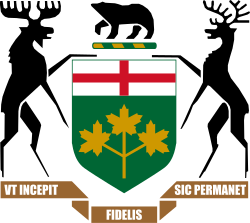Ontario Disability Support Program
hideThis article has multiple issues. Please help or discuss these issues on the talk page. (Learn how and when to remove these template messages)
|

| Disability |
|---|
|
The Ontario Disability Support Program (ODSP)[1] is a means-tested government-funded last resort income support paid for qualifying residents in the province of Ontario, Canada, who are above the age of 18 and have a disability.[2] ODSP and Ontario Works (OW)[3] are the two main components of Ontario's social assistance system. Like most social programs in Canada, the program is funded by the government of the province. The Ministry of Community and Social Services is responsible for ODSP and OW.[4]
This is unlike Social Security Disability in the United States which is a federally funded program under the umbrella of an Old Age Pension but provides similar benefits—regardless of the state of residence.
The ODSP is defined by provincial legislation, the ODSP Act, and its supporting regulations.[5] It is managed through policy directives.[6]
Unlike Ontario Works, ODSP does not require recipients to undertake employment-related activities like job searching, or vocational training. This is determined through a subjective evaluation of four criteria[2] that are defined within the ODSP Act:[5]
- The disability is continuous or recurrent;
- It is expected to last for a year or more;
- The disability significantly limits their ability to work, look after themselves, or get out in the community; and
- It has been verified by an approved health professional.
For recipients wishing to work, an optional component provides employment support funding, such as referral to a specialized employment counsellor.[7]
ODSP is meant to replace the income lost due to the recipient's disability making them unable to work enough to gain self-sufficiency and thus has a higher rate of assistance and asset limits than Ontario Works does.
Verification process[]
The Disability Determination Package is used to collect information about the disability.
The two main parts of the Disability Determination Package must be completed by an approved healthcare professional. These parts are:
Health Status Report - collects information about the applicant's medical condition, its impairments, restrictions and expected duration, as well as treatments Activities of Daily Living Index - collects information about the impact of impairment on the ability to work, care for self and participation in the community Healthcare professionals who are approved to complete both the Health Status Report and Activities of Daily Living Index:
- ophthalmologists
- optometrists
- physicians
- psychological associates
- psychologists
- registered nurses in the extended class
Healthcare professionals who are approved to complete the Activities of Daily Living Index only:
- audiologists
- chiropractors
- occupational therapists
- physiotherapists
- registered nurses
- social workers
- speech-language pathologists
Benefits[]
The program is paid monthly to a "benefit unit" which can consist of a single person between 18 and 65 (or a senior citizen who is ineligible for Old Age Security or Canada Pension Plan) and any others who may require the person's support. This can be any corresponding dependent adults who do not qualify for assistance (though they are subject to workfare requirements)[citation needed], children under the individual's care, or a spouse.[citation needed] The ODSP benefit has two main components:[citation needed] a fixed basic needs allowance, and an amount for housing that is variable.[citation needed] For those who do not have independent cooking facilities and/or cannot provide grocery receipts, a "Board and Lodging" amount is provided instead.[citation needed] All costs are verified through submitted receipts and information sharing among other government agencies.[citation needed]
In addition to employment supports and financial assistance, the ODSP provides health-related benefits to assist recipients with their medical needs.[8] These include:
- Prescription medication coverage (for medications listed on the Ontario Drug Benefit formulary)[9] - a co-payment may apply [10]
- Dental coverage
- Vision care (including assistance with the purchase of eyeglasses)
- Medical transportation assistance (verified as medically necessary by a doctor)
- Nutritional assistance for pregnant and breastfeeding women.
- Coverage for medical supplies related to a recipient's disability
- Transitional coverage for those who no longer meet financial eligibility or move on to full-time work.
- Financial assistance to help recipients and their families with essential living expenses
- Help to find and to keep a job, and advancing a career
See also[]
References[]
- ^ "About the Ontario Disability Support Program". Ontario Government.
- ^ Jump up to: a b "ODSP: Who is eligible". Ontario Government.
- ^ "About Ontario Works". Ontario Government.
- ^ "About Social Assistance". Ontario MCSS.
- ^ Jump up to: a b "Ontario Disability Support Program Act, 1997 ONTARIO REGULATION 222/98". Ontario Gazette. Retrieved 21 December 2013.
- ^ "Social Assistance Directives".
- ^ "Employment Supports: What it is". Ontario MCSS. Retrieved 21 December 2013.
- ^ "ODSP Health Benefits". Ontario MCSS.
- ^ "Ontario Drug Benefit - Formulary Search". Ministry of Health, Government of tOntario. Archived from the original on 4 February 2014. Retrieved 15 October 2014.
- ^ "The Ontario Drug Benefit (ODB program)". Ministry of Health and Long Term Care—Government of Ontario. Retrieved 15 October 2014.
External links[]
- Health in Ontario
- Government of Ontario
- Disability organizations based in Canada
- Social security in Canada